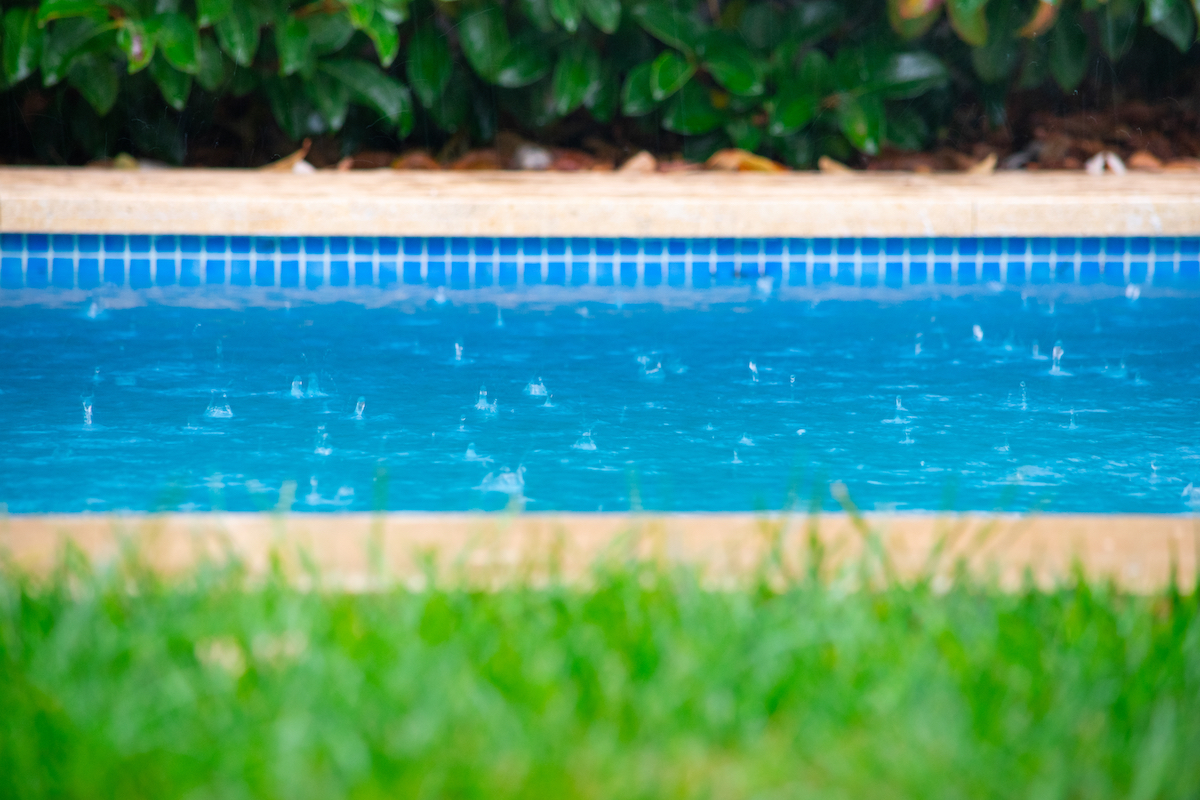RELATED: If You See This in a Hot Tub, Don’t Go In, Experts Say. You may not think much of it if you see a rain drop hit the pool when you’re swimming, but it’s important to be aware of how quickly a storm can escalate, specifically when lightning and thunder are involved. Safety experts caution swimmers and pool owners that as soon as a storm turns electrical, there’s a serious risk of electrocution to anyone in the water, and the pool should be vacated with immediate effect at the first sign of the weather turning. “Swimming during a thunderstorm is one of the most dangerous things you can do,” the experts at Sunsational Swim School explain. “Lightning regularly strikes water, and since water conducts electricity, a nearby lightning strike could kill or injure you. Any time you hear thunder, or see lightning, you should get out of the water and into a safe place.” Ron Holle, research meteorologist at NOAA National Severe Storms Laboratory, explained to USA Today that while swimming pools are small and not likely to be directly hit by lightning, “the area affecting a pool is quite large.” Power lines, telephone lines, and plumbing around the pool “are usually unsafe places during a thunderstorm because the current from a lightning strike will travel easily through the standing water, showers, and other plumbing. Since the pump, lights, and other facilities have power lines linked to the plumbing, a hit to any part of a pool complex can affect all of it,” Holle says. Plumbing expert Ray Brosnan previously told Best Life that “if lightning strikes, the electrical current will follow the path it finds with the least resistance all the way down to the ground. That means if your body is the best conductor in the vicinity, it’ll travel through you too.” He adds: “When you are wet, the natural resistance your body has to lightning is slashed in half.” RELATED: Never Go in a Lake If You See This One Thing, Local Officials Warn.ae0fcc31ae342fd3a1346ebb1f342fcb Normal levels of background noise and conversation can mean the difference between hearing thunder when it’s up to 25 miles away, or when it’s just a few miles from your pool. The ability of lightning to strike from anywhere in this range of distance means that if the storm is not visibly overhead, stray bolts can still hit you. The experts at Sunsational Swim School note that “even if current lightning is a few miles away, lightning can pop up in new parts of the storm very quickly.” So it’s best to get out of the pool as soon as you seen rain start to fall. The safety guide from Pool Troopers, a national pool company, says “many pool owners easily misjudge the distance of lightning because it may seem very far away.” Typically, Holle says you can hear thunder about 10 miles away, but “in a noisy place, if the wind is blowing, or it is raining, thunder can only be heard for few miles.” And while you may be able to see lightning up to 80 miles away on a clear night, during the day, you can’t see lightning more than 10 or 20 miles in the distance, he explains. “If you hear thunder, you’re always in the range of lightning,” the experts at Pool Troopers point out. “That does not mean that lightning can’t reach you if you can’t hear thunder, however. If you know a storm is in the area get out of the water even if you don’t hear thunder.” RELATED: For more up-to-date information, sign up for our daily newsletter. If you’re at a pool in someone’s yard with a pergola or other similar shelter, that’s not far enough away or enclosed enough to consider yourself safe. The National Weather Service explains that “buildings with exposed sides are NOT safe (even if they are “grounded”). These include beach shacks, metal sheds, picnic shelters/pavilions, carports, and baseball dugouts. Porches are dangerous as well.” Once indoors, be sure to stay away from any windows, doors, or concrete floors or walls. Concrete sits atop metal decking, which can easily conduct electricity. “Lightning can travel through any metal wires or bars in concrete walls or flooring,” the CDC says. If you can’t get inside a safe building, a car is the next best spot to be. Holle points out that a lightning threat typically “lasts less than an hour. So, instead of leaving [the pool] for the day, it would seem reasonable to wait in the car or another lightning-safe place until the thunderstorm has passed, then return.” He suggests waiting at least 30 minutes to go back in the pool. “We recommend a 30-minute wait after the last flash or thunder. The two together provide the basis for the ‘30-30 rule’. The first 30 is for the 30-second flash-to-bang time when a safe place should have been reached. The other 30 is for the 30 minutes’ wait after the last lightning or thunder,” he says. RELATED: The CDC Warns You Should Never Do This in Your House During a Storm.



